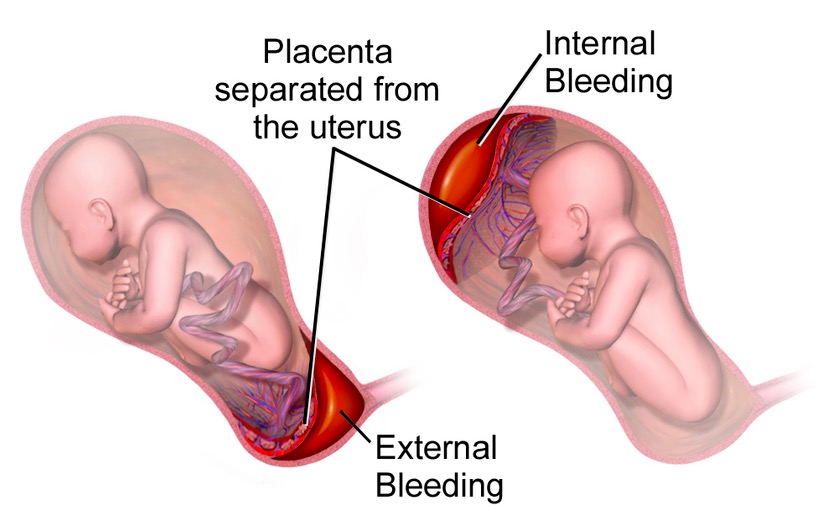Playlist
Show Playlist
Hide Playlist
Antepartum Hemorrhage
-
Slides AntepartumHemorrhage Obstetrics.pdf
-
Download Lecture Overview
00:01 Now let's discuss Antepartum Hemorrhage. 00:03 So there are several causes of Antepartum Hemorrhage. 00:07 But these are the most common. 00:09 Placenta previa, Placenta abruption, Vasa previa and then uterine rupture. 00:14 Let's talk about placenta previa first. 00:17 So placenta previa is a condition in which the placenta is in front of the baby covering the cervical os. 00:23 Now how do you if a patient has placenta previa? Well, there's a few things that they will present with. 00:28 The first and the most important is that they have painless vaginal bleeding. 00:33 You'll see this is different in some of the other presentations where there is pain associated with the vaginal bleeding. 00:39 For patients that have a placenta previa, you want to make sure that you do not perform a digital or speculum exam. 00:45 Doing so could disrupt the placenta and that mom could hemorrhage to death. 00:51 Because the placenta is in front of the cervix, our management delivery by C-section. 00:58 So let's move on to placental abruption. 01:01 Placental abruption happens when placenta prematurely separates from the uterus. 01:06 You can have a concealed or internal hemorrhage from that or you can have external bleeding if it's significant enough. 01:13 Now what are the causes of placental abruption? Hypertension is the most common. 01:18 But also trauma, cocaine or tobacco use or quick decompression of the uterus. 01:24 So for example, a mom that has polyhydramnios, extra fluid, when her water bag ruptures, the uterus decompresses very quickly. 01:33 And that can actually lead to placental abruption. 01:36 So vasa previa is a condition where the vessels traverse the cervical os. 01:41 As you can see in the picture, the vessels are in front of the fetal head. 01:45 Now this can be very traumatic for labor, specially if you have artificial rupture of membranes. 01:51 If you do this, you will actually start to make those vessels bleed and the baby can exsanguinate. 01:57 This is usually diagnosed on ultrasound. 02:02 And next is uterine rupture. 02:06 So with uterine rupture, the previous C-section scar made a hiss and the uterus can open up. 02:12 This is a cause of severe pain and also of heavy vaginal bleeding. 02:17 So let's go through a case. 02:20 A 19 year old Gravida 1 Para 0 female with an intrauterine pregnancy at 34 weeks and 2 days presents to labor and delivery with complaint of heavy vaginal bleeding. 02:31 It is associated with severe abdominal pain. 02:34 She has a history of drug abuse throughout her pregnancy. 02:37 On physical exam her blood pressure is 90 over 50 with a pulse of 120 and a fetal heart rate of 90 beats per minute. 02:45 What is the initial step in her management? Would it be, A. Order a urine toxicology. 02:52 B. Perform an emergency C-section C. Establish IV access with two large bore IV needles. 02:59 or D. Perform an ultrasound for location of the placenta. 03:02 The answer is C. 03:05 We always want to make sure we stabilize our patient. 03:08 And this patient she is actually going into shock. 03:10 Yes, she does use drugs and she probably is having a placental abruption from hypertension from the drugs. 03:18 But now she is actually in shock and that's why her blood pressure is low. 03:21 Her pulse rate is high. 03:23 So the first thing you want to do is assess your patient and resuscitate your patient before moving on to the cause of bleeding. 03:30 And that is why establishing an IV and starting IV fluids is the right answer in this case.
About the Lecture
The lecture Antepartum Hemorrhage by Veronica Gillispie, MD, MAS, FACOG is from the course Antenatal Care. It contains the following chapters:
- Antepartum Hemorrhage
- Placenta Previa
- Placental Abruption
- Vasa Previa
- Uterine Rupture
Included Quiz Questions
Which of the following is defined as premature separation of the placenta from the uterus?
- Placental abruption
- Placenta previa
- Placenta increta
- Placental rupture
- Uterine rupture
A 22-year-old G1P0 at 24 weeks gestation presents to the emergency room with painless heavy vaginal bleeding after intercourse. She denies any drug use or medical problems during this pregnancy. She has soaked through 4 large pads in the past 1 hour. Her blood pressure is 95/50 with a heart rate of 105 bpm. After starting emergent IV fluids, what is the next step in work-up?
- Ultrasound to evaluate for placenta previa
- Digital cervical exam to evaluate for pre-term labor
- Speculum exam to rule out cervical polyp
- Umbilical cord doppler to evaluate for placental blood flow
- Abdominal CT scan to check for uterine rupture
A G2P1 woman with a history of a cesarean section for her first delivery is seven hours into her trial of labor. Her last cervical exam one hour ago showed 5 cm dilation with fetal cephalic station 1 cm above the ischial spines of the pelvis (-1 station) and Pitocin (oxytocin) augmentation was started at that time. The patient is experiencing a sudden increase in vaginal bleeding and severe abdominal pain and tenderness. Fetal heart rate has dropped to 90 bpm and is continuing to drop, you call for an emergency c-section, and as you are rolling the patient into the operating room, you perform a rapid cervical exam to find fetal station is now too high to be reached. What is the likely cause of this obstetrical emergency?
- Uterine rupture
- Placenta previa bleeding due to digital cervical exams
- Vasa previa bleeding due to digital cervical exams
- Vasa previa bleeding due to rupture of membranes
- Umbilical cord disruption from the placenta during labor
Customer reviews
5,0 of 5 stars
| 5 Stars |
|
1 |
| 4 Stars |
|
0 |
| 3 Stars |
|
0 |
| 2 Stars |
|
0 |
| 1 Star |
|
0 |
Incredible lecture, so clear and concise explanation. Thank u very much




